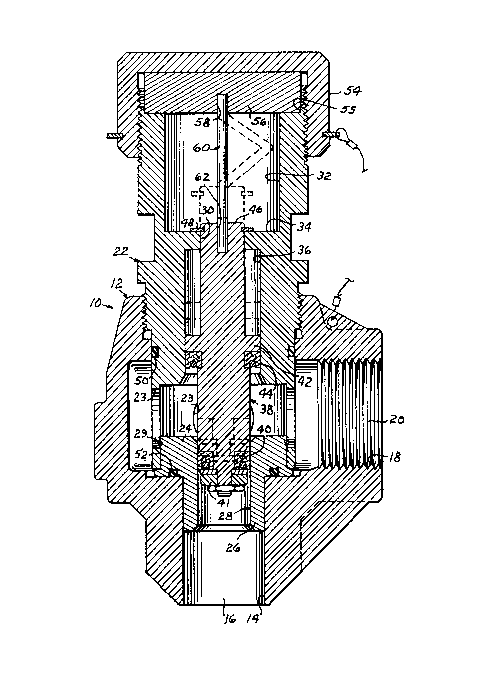Une partie des informations de ce site Web a été fournie par des sources externes. Le gouvernement du Canada n'assume aucune responsabilité concernant la précision, l'actualité ou la fiabilité des informations fournies par les sources externes. Les utilisateurs qui désirent employer cette information devraient consulter directement la source des informations. Le contenu fourni par les sources externes n'est pas assujetti aux exigences sur les langues officielles, la protection des renseignements personnels et l'accessibilité.
L'apparition de différences dans le texte et l'image des Revendications et de l'Abrégé dépend du moment auquel le document est publié. Les textes des Revendications et de l'Abrégé sont affichés :
| (12) Brevet: | (11) CA 1285454 |
|---|---|
| (21) Numéro de la demande: | 1285454 |
| (54) Titre français: | SOUPAPE DE DETENTE |
| (54) Titre anglais: | PRESSURE RELIEF VALVE |
| Statut: | Durée expirée - après l'octroi |
| (51) Classification internationale des brevets (CIB): |
|
|---|---|
| (72) Inventeurs : |
|
| (73) Titulaires : |
|
| (71) Demandeurs : | |
| (74) Agent: | BORDEN LADNER GERVAIS LLP |
| (74) Co-agent: | |
| (45) Délivré: | 1991-07-02 |
| (22) Date de dépôt: | 1987-11-12 |
| Licence disponible: | S.O. |
| Cédé au domaine public: | S.O. |
| (25) Langue des documents déposés: | Anglais |
| Traité de coopération en matière de brevets (PCT): | Non |
|---|
| (30) Données de priorité de la demande: | ||||||
|---|---|---|---|---|---|---|
|
Abstract
A valve body having a lateral exhaust port is provided with
a valve movable toward and away from a fluid inlet sealing face
at its pressure connected end and guided by a valve stem project-
ing through the other end of the body and terminating in spaced
relation with respect to a cap closing the end of the body oppo-
site its inlet port. An axially collapsible member is axially
interposed between the downstream end of the valve stem and the
cap to normally maintain the the flow passageway between the
ports closed. Excessive fluid pressure against the valve at the
inlet port collapses the collapsible member, unseats the valve
and opens the fluid discharge passageway.
Note : Les revendications sont présentées dans la langue officielle dans laquelle elles ont été soumises.
Note : Les descriptions sont présentées dans la langue officielle dans laquelle elles ont été soumises.

2024-08-01 : Dans le cadre de la transition vers les Brevets de nouvelle génération (BNG), la base de données sur les brevets canadiens (BDBC) contient désormais un Historique d'événement plus détaillé, qui reproduit le Journal des événements de notre nouvelle solution interne.
Veuillez noter que les événements débutant par « Inactive : » se réfèrent à des événements qui ne sont plus utilisés dans notre nouvelle solution interne.
Pour une meilleure compréhension de l'état de la demande ou brevet qui figure sur cette page, la rubrique Mise en garde , et les descriptions de Brevet , Historique d'événement , Taxes périodiques et Historique des paiements devraient être consultées.
| Description | Date |
|---|---|
| Inactive : Périmé (brevet sous l'ancienne loi) date de péremption possible la plus tardive | 2008-07-02 |
| Inactive : CIB de MCD | 2006-03-11 |
| Accordé par délivrance | 1991-07-02 |
| Déclaration du statut de petite entité jugée conforme | 1987-11-12 |
Il n'y a pas d'historique d'abandonnement
| Type de taxes | Anniversaire | Échéance | Date payée |
|---|---|---|---|
| TM (catégorie 1, 6e anniv.) - petite | 1997-07-02 | 1997-06-27 | |
| TM (catégorie 1, 7e anniv.) - petite | 1998-07-02 | 1998-06-26 | |
| TM (catégorie 1, 8e anniv.) - petite | 1999-07-02 | 1999-06-29 | |
| TM (catégorie 1, 9e anniv.) - petite | 2000-07-04 | 2000-06-29 | |
| TM (catégorie 1, 10e anniv.) - petite | 2001-07-03 | 2001-06-20 | |
| TM (catégorie 1, 11e anniv.) - petite | 2002-07-02 | 2002-07-02 | |
| TM (catégorie 1, 12e anniv.) - petite | 2003-07-02 | 2003-04-25 | |
| TM (catégorie 1, 13e anniv.) - petite | 2004-07-02 | 2004-06-28 | |
| TM (catégorie 1, 14e anniv.) - petite | 2005-07-04 | 2005-06-29 | |
| TM (catégorie 1, 15e anniv.) - petite | 2006-07-04 | 2006-07-04 | |
| TM (catégorie 1, 16e anniv.) - petite | 2007-07-03 | 2007-07-03 |
Les titulaires actuels et antérieures au dossier sont affichés en ordre alphabétique.
| Titulaires actuels au dossier |
|---|
| JULIAN S. TAYLOR |
| Titulaires antérieures au dossier |
|---|
| S.O. |